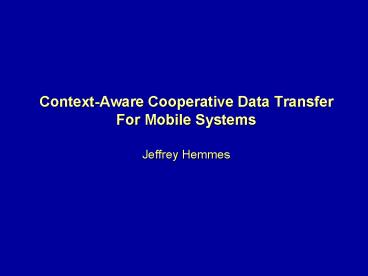ContextAware Cooperative Data Transfer - PowerPoint PPT Presentation
1 / 14
Title:
ContextAware Cooperative Data Transfer
Description:
Resources may be shared among team members. Resources limited ... Buffer. Display. Network. Card. Routing. Table. Timer. Resource. Monitor. Disk. Batt. GPS Data ... – PowerPoint PPT presentation
Number of Views:13
Avg rating:3.0/5.0
Title: ContextAware Cooperative Data Transfer
1
- Context-Aware Cooperative Data Transfer
- For Mobile Systems
- Jeffrey Hemmes
2
Overview
- Problem Definition and Motivation
- Context-Aware Data Transfer
- System Architecture
- Implementation
- Evaluation
- Conclusions
3
Background
- Crisis response systems
- Mobile ad-hoc networks
- Highly dynamic topology
- Device locations change frequently
- Operators work towards a common goal, but...
different roles may imply different data sets - Resources may be shared among team members
- Resources limited
- Capabilities vary by device
- Cannot broadcast all data to all devices
- Must limit extraneous data transfers
- Data should still be preserved!
4
Objective
Use both system state and dynamic
location information to make real-time node
selection decisions in cooperative storage
systems.
5
Context-Aware Data Transfer
- We have
- TeamTrak platform
- Routing protocol containing GPS information
- Basic Idea
- Add system state to routing protocol
- Measure size of data to be transferred
- Use system state for peers to determine if
- sufficient resources available
- Use location history to determine if enough
- time exists to complete data transfer
6
System Architecture
Resource Monitor
Routing Table
Route Data
Disk
Batt
GPS Thread
Window Event Handler
Ethernet Thread
Data
Timer
GPS Data
Route Data
Buffer
Buffer
Display
GPS Receiver
Network Card
7
Peer Selection
- Nodes initially scored as route packets arrive
- Insufficient storage space/battery life ? score 0
- All others become candidate nodes ? score 1
- State info/node score recorded in routing table
- Location history of candidate nodes recorded
- Linear extrapolation of location history used to
- compute window of opportunity for data transfer
- Node with largest window of opportunity
- selected
8
Peer Selection
Wireless Range
9
Data Transfer and Recovery
- Each node functions as lightweight file server
- TCP connection established between nodes
- For each file in the data list
- Send an RPC with the file name and size in bytes
- Receiving node sends an acknowledgement
- Transfer data
- When specified number of bytes received,
receiving node sends another acknowledgement - Note this only works for single hops!
10
Data Transfer and Recovery
- Data may have been transferred from its original
backup location - Originating node broadcasts request for any data
belonging to it - Nodes holding copies of the data send ACK
- Files transferred back to originating node
11
Fault Tolerance
- System is designed to be reasonably fault
tolerant, but many boundary cases exist - What happens if
- No suitable peer is found?
- File transfer fails?
- Peers suddenly change direction?
- Data is positioned more than one hop away?
- etc
- This system is fully cooperativewhat about
permissions and security policies?
12
Evaluation
13
Conclusions
- Context-aware data transfer allows data
- preservation without excessive transmissions
- Evaluates system state and predicted
availability - to make node selection decisions
- May have applications beyond cooperative
- storage
14
For More Information
- Jeffrey Hemmes
- Cooperative Computing Lab
- www.cse.nd.edu/jhemmes
- hemmes_at_cse.nd.edu
15
Related Work
- Geographic Forwarding
- Static Network Topology
- Routing Protocol Only
- FlashBack
- Measures Relative Location Only
- Determines Proximity via Message Traffic
- Others
16
Future Work
- Multihop file transfer protocol over UDP
- Security architecture
- How do failure semantics mesh with permissions
and security policies? - What effect does security have on time-critical
offloads? - Can this method be used or adapted to choose an
optimal route instead of a single node?
17
Resource Monitor
- Polls battery level every 5 seconds
- Measures available storage space
- Measures size of designated files
- Battery level/free space added to routing packet
- Routing packet broadcast via timer function
Route header
Routing Table Entries
name ttid battery space gateway etc.
Routing Table Entry 1
Routing Table Entry 2
Routing Table Entry 3
Routing Table Entry 4































